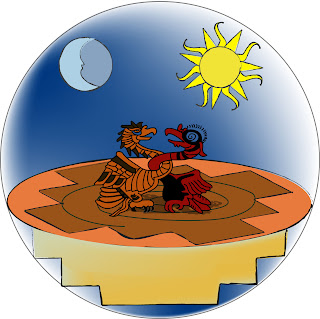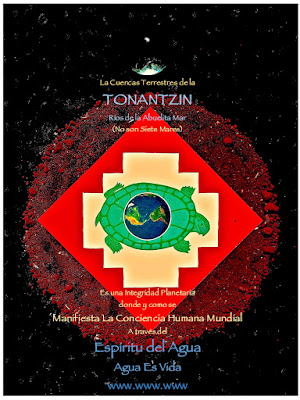By Tupac Enrique Acosta
April 27, 2103
She had travelled over a thousand
miles and bridged a thousand years of history, but when Vicky Flores Flores
arrived at ASU West last week to participate in the DISMANTLING the Doctrine of Discovery International Conference, she
was returning for the third time to visit her relatives among the O’otham
Nations. She came from the
traditional O’dam Community of Santa Maria Ocotan in the State of Durango,
Mexico which lies along the Eastern flank of the Sierra Madre Occidental
mountain range in the heart of Mexico.
Her people, also known as the Tepehuano, consist of some 26,000 O’dam
peoples distributed in 2 municipalities and 6 communities that cover one of the
largest land bases of Indigenous Peoples south of the US-Mexico border. A majority of the O’dam of Durango are
still fluent in the language. Santa
Maria Ocotan lies at about 9,000 feet elevation among the mountain pine forests
of the Sierra Madre Occidental.
 |
| Map by Tupak Huehuecoyotl |
I first met Vicky in Mexico City
at a continental Indigenous Summit in 2010, where I was doing media work,
recording interviews of the different delegates from across the hemisphere that
were attending. When I asked her
for an interview she graciously agreed and it became very clear to me very
quickly that this was a special opportunity. In beginning the interview when I asked Vicky to introduce
herself, she stated she was “O’dam”.
We were conversing in Spanish but I then told her that I lived in
Arizona which was the homeland of the O’otham nations, and shared a few
O’odham words that I had picked up from talking with Shannon Rivers of the Gila
River Akimel O’otham. The rest is
not only history, but perhaps at the end of the day her travels to the O’otham
Jeved here in the north may become the fulfillment of prophecy.
It was in 1990, in Quito Ecuador
that the First Continental
Encounter of
Indigenous Nations, Pueblos, and Organizations convened for the first time
after nearly 500 years of colonization and genocide. We gathered in Quito over twenty years ago to reaffirm our
self-determination as Nations and Pueblos of Indigenous Peoples of the
continent, and made commitments to each other as survivors of the greatest
holocaust ever committed upon humanity to organize ourselves together under the
principles of the Continental
Confederation of the Eagle and the Condor. According to traditional histories, this ancient
continental confederacy was the original United Nations of the hemisphere, and
extended from pole to pole and coast to coast across our entire continent of Abya Yala [the Americas]. The Eagle represents the symbol of the
Indigenous Nations of the North and the power of “Sees Far”, while the Condor represents the Indigenous Nations of
the South and the power of “Sees Within.”
At that gathering in 1990 in
Quito, it was revealed that along with the tradition and memory of the Eagle
and the Condor came a legend of the Prophecy of the Reuniting of the Eagle and
Condor in a process of healing from the violence and trauma of centuries of colonization.
The two-day international conference
on DISMANTLING the Doctrine of Discovery held at ASU West last week was a
continuation of that decolonizing work,
and also a fulfillment of those obligations made twenty-two years ago, but the
story goes back of course even further.
TONATIERRA of the Izkaloteca,
Maya Vision of the Maya Nations, and the Techantit Cultural Center of the
Nahuat Pipil Nations were the conveners of this international conference. Among these three organizations, within
our shared cultural mandates and instructions, in spite of the centuries of oppression,
suppression, and repression, there continues till today the interdependence and
foundation in daily practice of our ancient calendar systems and teachings of
the milpa, our ways of life as People
of the Corn Mother. When we look
forward from this perspective, and with these teachings, it is a vision of the
past seen from the future that we become.

And so when Vicky Flores Flores
arrived at Sky Harbor airport in Phoenix on Friday April 19th after having to
sleep overnight in the airport in Mexico City because of a mix up in the
connecting flight, she was just in time to make it to the afternoon session of
the DISMANTLING conference and give
the closing remarks at the end of the first day. She spoke in
her O’dam language, and as had occurred during each of her other prior visits
to Arizona, the O’otham relatives could understand her message.

The event convened a broad representation of academics and
Indigenous leaders from across the hemisphere who presented on the historical
process of the imposition of the Doctrine of Discovery over the past five
centuries, within the present context of Dismantling the Doctrine of Discovery as called for by the UN
Permanent Forum on Indigenous Issues during the 11th Session of
May 7-18, 2012 in New York. Two recommendations from this session of the UNPFII served
as objectives for implementation for the DISMANTLING the Doctrine of Discovery
International Conference (DDD):
4.
The Permanent Forum recalls the fourth preambular paragraph of the United
Nations Declaration on the Rights of Indigenous Peoples, which affirms that all
doctrines, policies and practices based on or advocating superiority of peoples
or individuals on the basis of national origin or racial, religious, ethnic or
cultural differences are racist, scientifically false, legally invalid, morally
condemnable and socially unjust. Legal and political justification for the
dispossession of indigenous peoples from their lands, their disenfranchisement
and the abrogation of their rights such as the doctrine of discovery, the
doctrine of domination, “conquest”, “discovery”, terra nullius or the Regalian doctrine were adopted by colonizers
throughout the world. While these
nefarious doctrines were promoted as the authority for the acquisition of the
lands and territories of indigenous peoples, there were broader assumptions
implicit in the doctrines, which became the basis for the assertion of authority
and control over the lives of indigenous peoples and their lands, territories
and resources. Indigenous peoples were constructed as “savages”, “barbarians”,
“backward” and “inferior and uncivilized” by the colonizers who used such
constructs to subjugate, dominate and exploit indigenous peoples and their
lands, territories and resources. The Permanent Forum calls upon States to
repudiate such doctrines as the basis for denying indigenous peoples’ human
rights.
9.
The Permanent Forum recommends that States include in all education curricula, in particular the school system, a discussion
of the doctrine of discovery/dispossession and its contemporary manifestations,
including land laws and policies of removal.

In bringing these issues forward
towards implementation, nearly one hundred high school students including
members of the Native American
Educational Program of the Phoenix Union High School District attended the
conference. Chief Jake Edwards of
the Onondaga Nation, members of the Haudensaunee - People of the Longhouse also
known as the Iroquois Confederacy shared the message of Great Law of Peace with
all conference attendees, which also included many non-indigenous folks. Chief Edwards presented on the history
of the confederacy, and its establishment over a thousand years ago as the
oldest democracy in the continent.
He also shared the story and meaning of the Haudenosaunee Wampum Belts which document the principles of mutual
respect and self-determination that must prevail between the Indigenous Nations
and the non-indigenous societies of the settler states of the Americas.
 |
| Onondaga Nation Chief Jake Edwards |
Also
attending the conference were delegations of Nations and Pueblos of Indigenous
Peoples from the entire hemisphere, from the Lenape of the North [Canada] to
the Mapuche Nation of the South [Chile].
Representatives of the Maya of Totonicapan [Guatemala] and the Nahuat
Pipil [El Salvador] , the Arhuaco and Embera [Colombia] joined with Indigenous
Nations of the O’otham [Arizona] and the O’dam of Mexico [Durango] and the
Havasupai to receive the Continental
Confederation of Indigenous Nations of Abya Yala intent on regenerating the
historical and political vision of responsibility and traditional alliance that
has sustained the collective cultural identity and nationhood of Indigenous
Peoples for millennia.
 |
| Sharing at Gila River Rez |
Before
returning back to Mexico, Vicky Flores Flores visited among the O’otham Nations
relatives of Salt River and Gila River communities sharing language, food and
the spirit of the O’otham-O’dam Himdag, for which there is no border on the
land or in time which cannot be overcome with patience, hard work, and a lot of
love.
Epilogue
This story is to be continued, as Vicky
Flores Flores has extended and invitation to receive a delegation of the O’tham
to visit her home community in Durango, Mexico. Plans are still in the making,
but she suggested that the best opportunity falls in Mid- May when the O’dam
ceremonies are in full swing. Keep
posted.
Tupac
Enrique Acosta, Yaotachcauh
Tlahtokan
Nahuacalli
 |
| Gathering the Relatives at Salt River Rez |
Photos of Santa Maria Ocotan, Durango Mexico
Embassy of Indigenous Peoples
A
PROJECT
*******
Livestream Video Link:
DISMANTLING
The Doctrine of Discovery
**************
March 23, 2012
Virginia Flores Flores at the Arizona State Capitol House of Representatives
Message to the O'otham Nations

















